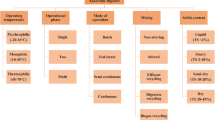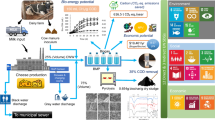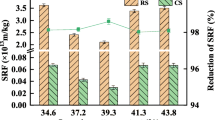Abstract
In anaerobic digestion processes, pH has a vital role due to the direct impacts on the microbial community. An eco-friendly approach has been applied to control pH in anaerobic bioreactors, using waste-containing fly ash geopolymer spheres (GS) instead of powdered chemical compounds, to promote continuous alkalis leaching. The influence of GS porosity and concentration on the behavior of anaerobic sequential batch reactor treating cheese whey was evaluated. Results showed that the use of GS with the highest concentration and porosity promoted an increase in methane yield up to 30%, compared to the assay with powdered chemical compounds addition. In addition, GS boosted butyric acid production to the detriment of propionic acid, which favored methane production by a factor up to 1.2. This innovative approach indicates that GS addition can regulate pH in anaerobic digesters treating challenging wastewaters and, simultaneously, improve not only its efficiency but also the sustainability of the entire process.







Similar content being viewed by others
Abbreviations
- AD:
-
Anaerobic digestion
- AnSBR:
-
Anaerobic sequential batch reactor
- COD:
-
Chemical oxygen demand
- CH4 :
-
Methane
- GS:
-
Geopolymer spheres
- HPGS:
-
High porosity geopolymers spheres
- LPGS:
-
Low porosity geopolymers spheres
- VFA:
-
Volatile fatty acids
References
Moguel-Castañeda JG, Puebla H, Méndez-Acosta HO, Hernandez-Martinez E (2020) Modeling pH and temperature effects on the anaerobic treatment of tequila vinasses. J Chem Technol Biotechnol. https://doi.org/10.1002/jctb.6361
Yoshida K, Kametani K, Shimizu N (2020) Adaptive identification of anaerobic digestion process for biogas production management systems. Bioprocess Biosyst Eng 43:45–54. https://doi.org/10.1007/s00449-019-02203-9
Vasco-Correa J, Khanal S, Manandhar A, Shah A (2018) Anaerobic digestion for bioenergy production: global status, environmental and techno-economic implications, and government policies. Bioresour Technol 247:1015–1026. https://doi.org/10.1016/j.biortech.2017.09.004
Hultberg M, Lind O, Birgersson G, Asp H (2017) Use of the effluent from biogas production for cultivation of Spirulina. Bioprocess Biosyst Eng 40:625–631. https://doi.org/10.1007/s00449-016-1726-2
Lin Q, De Vrieze J, Li C et al (2017) Temperature regulates deterministic processes and the succession of microbial interactions in anaerobic digestion process. Water Res 123:134–143. https://doi.org/10.1016/j.watres.2017.06.051
Amha YM, Anwar MZ, Brower A et al (2018) Inhibition of anaerobic digestion processes: applications of molecular tools. Bioresour Technol 247:999–1014. https://doi.org/10.1016/j.biortech.2017.08.210
Mukhuba M, Roopnarain A, Moeletsi ME, Adeleke R (2020) Metagenomic insights into the microbial community and biogas production pattern during anaerobic digestion of cow dung and mixed food waste. J Chem Technol Biotechnol 95:151–162. https://doi.org/10.1002/jctb.6217
Braguglia CM, Gallipoli A, Gianico A, Pagliaccia P (2017) Anaerobic bioconversion of food waste into energy: a critical review. Bioresour Technol 248:37–56. https://doi.org/10.1016/j.biortech.2017.06.145
Wang D, Ai J, Shen F et al (2017) Improving anaerobic digestion of easy-acidification substrates by promoting buffering capacity using biochar derived from vermicompost. Bioresour Technol 227:286–296. https://doi.org/10.1016/j.biortech.2016.12.060
Novais RM, Gameiro T, Carvalheiras J et al (2018) High pH buffer capacity biomass fly ash-based geopolymer spheres to boost methane yield in anaerobic digestion. J Clean Prod 178:258–267. https://doi.org/10.1016/j.jclepro.2018.01.033
Novais RM, Pullar RC, Labrincha JA (2020) Geopolymer foams: an overview of recent advancements. Prog Mater Sci 109:100621
Zhang Z, Provis JL, Reid A, Wang H (2014) Geopolymer foam concrete: an emerging material for sustainable construction. Constr Build Mater 56:113–127. https://doi.org/10.1016/j.conbuildmat.2014.01.081
Novais RM, Carvalheiras J, Senff L et al (2019) In-depth investigation of the long-term strength and leaching behaviour of inorganic polymer mortars containing green liquor dregs. J Clean Prod 220:630–641. https://doi.org/10.1016/j.jclepro.2019.02.170
Ji Z, Pei Y (2019) Bibliographic and visualized analysis of geopolymer research and its application in heavy metal immobilization: a review. J Environ Manage 231:256–267. https://doi.org/10.1016/j.jenvman.2018.10.041
Kwasny J, Soutsos MN, McIntosh JA, Cleland DJ (2018) Comparison of the effect of mix proportion parameters on behaviour of geopolymer and Portland cement mortars. Constr Build Mater 187:635–651. https://doi.org/10.1016/j.conbuildmat.2018.07.165
Novais RM, Senff L, Carvalheiras J et al (2018) Sustainable and efficient cork—inorganic polymer composites: an innovative and eco-friendly approach to produce ultra-lightweight and low thermal conductivity materials. Cem Concr Compos 97:107–117. https://doi.org/10.1016/J.CEMCONCOMP.2018.12.024
Luna-Galiano Y, Leiva C, Arenas C, Fernández-Pereira C (2018) Fly ash based geopolymeric foams using silica fume as pore generation agent. Physical, mechanical and acoustic properties. J Non Cryst Solids 500:196–204. https://doi.org/10.1016/j.jnoncrysol.2018.07.069
Novais RM, Carvalheiras J, Tobaldi DM et al (2019) Synthesis of porous biomass fly ash-based geopolymer spheres for efficient removal of methylene blue from wastewaters. J Clean Prod 207:350–362. https://doi.org/10.1016/j.jclepro.2018.09.265
Alzeer MIM, MacKenzie KJD (2018) Synthesis and catalytic properties of new sustainable aluminosilicate heterogeneous catalysts derived from fly ash. ACS Sustain Chem Eng 6:5273–5282. https://doi.org/10.1021/acssuschemeng.7b04923
Novais RM, Carvalheiras J, Seabra MP et al (2018) Innovative application for bauxite residue: Red mud-based inorganic polymer spheres as pH regulators. J Hazard Mater 358:69–81. https://doi.org/10.1016/j.jhazmat.2018.06.047
Bumanis G, Rugele K, Bajare D (2015) The effect of alkaline material particle size on adjustment ability of buffer capacity. Medziagotyra 21:405–409. https://doi.org/10.5755/j01.ms.21.3.7325
Novais RM, Seabra MP, Labrincha JA (2017) Porous geopolymer spheres as novel pH buffering materials. J Clean Prod 143:1114–1122. https://doi.org/10.1016/j.jclepro.2016.12.008
Novais RM, Buruberri LH, Seabra MP et al (2016) Novel porous fly ash-containing geopolymers for pH buffering applications. J Clean Prod 124:395–404. https://doi.org/10.1016/j.jclepro.2016.02.114
Zhang Z, Provis JL, Reid A, Wang H (2014) Fly ash-based geopolymers: the relationship between composition, pore structure and efflorescence. Cem Concr Res 64:30–41. https://doi.org/10.1016/j.cemconres.2014.06.004
Ruģele K, Bumanis G, Bajare D et al (2014) Alkaline activated material for pH control in biotechnologies. Key Eng Mater 604:223–226. https://doi.org/10.4028/www.scientific.net/kem.604.223
Bumanis G, Bajare D (2014) The effect of porous alkali activated material composition on buffer capacity in bioreactors. Int J Chem Nucl Metall Mater Eng 8:1040–1046
Montalvo S, Cahn I, Borja R et al (2017) Use of solid residue from thermal power plant (fly ash) for enhancing sewage sludge anaerobic digestion: Influence of fly ash particle size. Bioresour Technol 244:416–422. https://doi.org/10.1016/j.biortech.2017.07.159
Gertner P, Huiliñir C, Pinto-Villegas P et al (2017) A new model for including the effect of fly ash on biochemical methane potential. Waste Manag 68:232–239. https://doi.org/10.1016/j.wasman.2017.07.005
Silva FC, Serafim LS, Nadais H et al (2013) Acidogenic fermentation towards valorisation of organic waste streams into volatile fatty acids. Chem Biochem Eng Q 27:467–476
Van Lier JB, Rebac S, Lens P et al (1997) Anaerobic treatment of partly acidified wastewater in a two-stage expanded granular sludge bed (EGSB) system at 8 °C. Water Sci Technol 36:317–324. https://doi.org/10.1016/S0273-1223(97)00538-6
Guo Q, Majeed S, Xu R et al (2019) Heavy metals interact with the microbial community and affect biogas production in anaerobic digestion: a review. J Environ Manag 240:266–272. https://doi.org/10.1016/j.jenvman.2019.03.104
Bougrier C, Dognin D, Laroche C, Cacho Rivero JA (2018) Use of trace elements addition for anaerobic digestion of brewer’s spent grains. J Environ Manag 223:101–107. https://doi.org/10.1016/j.jenvman.2018.06.014
Vergine P, Sousa F, Lopes M et al (2015) Synthetic soft drink wastewater suitability for the production of volatile fatty acids. Process Biochem 50:1308–1312. https://doi.org/10.1016/j.procbio.2015.04.007
APHA, AWWA, WEF (2005) Standard methods for the examination of water and wastewater, 21st edn. Washington
Gameiro T, Sousa F, Silva FC et al (2015) Olive oil mill wastewater to volatile fatty acids: statistical study of the acidogenic process. Water Air Soil Pollut 226:115. https://doi.org/10.1007/s11270-015-2311-z
Couras CS, Louros VL, Gameiro T et al (2015) Anaerobic degradation of dairy wastewater in intermittent UASB reactors: influence of effluent recirculation. Environ Technol. https://doi.org/10.1080/09593330.2015.1025102
Gameiro T, Lopes M, Marinho R et al (2016) Hydrolytic-acidogenic fermentation of organic solid waste for volatile fatty acids production at different solids concentrations and alkalinity addition. Water Air Soil Pollut. https://doi.org/10.1007/s11270-016-3086-6
Gameiro T, Novais RM, Correia CL et al (2020) Red mud-based inorganic polymer spheres: innovative and environmentally friendly anaerobic digestion enhancers. Bioresour Technol. https://doi.org/10.1016/j.biortech.2020.123904
Baumann U, Müller MT (1997) Determination of anaerobic biodegradability with a simple continuous fixed-bed reactor. Water Res 31:1513–1517. https://doi.org/10.1016/S0043-1354(96)00406-X
Hassan AN, Nelson BK (2012) Invited review: anaerobic fermentation of dairy food wastewater. J Dairy Sci 95:6188–6203
Mainardis M, Flaibani S, Trigatti M, Goi D (2019) Techno-economic feasibility of anaerobic digestion of cheese whey in small Italian dairies and effect of ultrasound pre-treatment on methane yield. J Environ Manag 246:557–563. https://doi.org/10.1016/j.jenvman.2019.06.014
Antonopoulou G, Stamatelatou K, Venetsaneas N et al (2008) Biohydrogen and methane production from cheese whey in a two-stage anaerobic process. Ind Eng Chem Res 47:5227–5233. https://doi.org/10.1021/ie071622x
Mao C, Feng Y, Wang X, Ren G (2015) Review on research achievements of biogas from anaerobic digestion. Renew Sustain Energy Rev 45:540–555. https://doi.org/10.1016/j.rser.2015.02.032
Lee DJ, Lee SY, Bae JS et al (2015) Effect of volatile fatty acid concentration on anaerobic degradation rate from field anaerobic digestion facilities treating food waste leachate in South Korea. J Chem. https://doi.org/10.1155/2015/640717
Musa M, Idrus S, Che Man H, Nik Daud N (2018) Wastewater treatment and biogas recovery using anaerobic membrane bioreactors (AnMBRs): strategies and achievements. Energies 11:1675. https://doi.org/10.3390/en11071675
Ruģele K, Skripsts E, Mezule L et al (2015) Use of alkali-activated aluminosilicate material to enhance biogas production from acidic whey. Open Biotechnol J 9:54–60. https://doi.org/10.2174/1874070701509010054
Mainardis M, Buttazzoni M, Goi D (2020) Up-flow anaerobic sludge blanket (UASB) technology for energy recovery: a review on state-of-the-art and recent technological advances. Bioengineering 7:43. https://doi.org/10.3390/bioengineering7020043
Acknowledgements
R. M. Novais and J. Carvalheiras wish to thank Fundação para a Ciência e a Tecnologia (FCT) for supporting their work (Ref. CEECIND/00335/2017 and SFRH/BD/144562/2019). This work was developed within the scope of the project CESAM—Centre for Environmental and Marine Studies (UIDP/50017/2020 and UIDB/50017/2020), and CICECO—Aveiro Institute of Materials (UIDB/50011/2020 and UIDP/50011/2020), both financed by national funds through the FCT/MCTES.
Author information
Authors and Affiliations
Corresponding author
Ethics declarations
Conflict of interest
The authors declare that they have no conflict of interest.
Additional information
Publisher's Note
Springer Nature remains neutral with regard to jurisdictional claims in published maps and institutional affiliations.
Rights and permissions
About this article
Cite this article
Gameiro, T., Novais, R.M., Correia, C.L. et al. Role of waste-based geopolymer spheres addition for pH control and efficiency enhancement of anaerobic digestion process. Bioprocess Biosyst Eng 44, 1167–1183 (2021). https://doi.org/10.1007/s00449-021-02522-w
Received:
Accepted:
Published:
Issue Date:
DOI: https://doi.org/10.1007/s00449-021-02522-w




